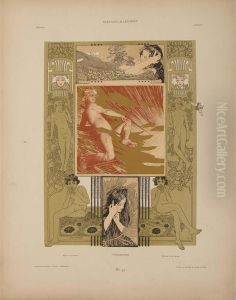Martin Gerlach Paintings
Martin Gerlach was an Austrian photographer, graphic designer, and publisher born in 1846 in Austria. Not as widely known as some of his contemporaries, Gerlach nevertheless made significant contributions to the field of graphic arts during the late 19th and early 20th centuries. He was particularly recognized for his work in the area of decorative arts and his role in the development of the graphic industry in Vienna.
Gerlach's career took off in the latter half of the 19th century, a time when the decorative arts were undergoing a transformation across Europe. The rise of movements like Art Nouveau, which emphasized ornate, natural forms, provided a backdrop for Gerlach's work. He was deeply influenced by the prevailing tastes of the time and was involved in the publication of a series of portfolios titled 'Gerlach's Allegories,' which were collections of designs and patterns intended for use by craftsmen and designers. These allegories were widely circulated and used as a source of inspiration for decorative motifs.
In addition to his work with patterns and allegories, Gerlach also worked with photography, an art form that was still in its relative infancy and rapidly evolving during his lifetime. He was adept at utilizing the latest photographic technologies to produce high-quality images that were often incorporated into his published works.
Throughout his life, Gerlach's work reflected the changing aesthetic sensibilities and the growing industrialization of the graphic arts. His contributions were part of the larger Secessionist movement in Vienna, which sought to break away from traditional artistic conventions and promote a more modern, progressive approach to art and design.
Martin Gerlach passed away in 1918, leaving behind a legacy that is sometimes overshadowed by his more famous peers but nevertheless important for understanding the development of graphic design and photography in Austria at the turn of the century. His work continues to be a subject of interest for historians and collectors who are fascinated by the rich visual culture of this period.
